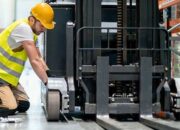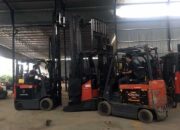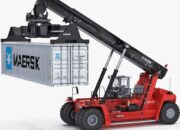Structural characteristics and technical characteristics of electric forklifts
An electric forklift is a loading and unloading and handling vehicle powered by a DC power source (battery). According to foreign statistics, the production of electric forklift trucks in Japan has exceeded one-third of the total number of forklifts. In some Western European countries such as Germany and Italy, the percentage of electric forklift trucks has reached about 50%. The rapid growth of electric forklifts is mainly due to the constant advancement of different manufacturers. Most of the products adopt streamlined design, the shape is more beautiful. Major manufacturers have achieved large-scale production, specialized production of parts and assembly line operations. Machining accuracy and degree of automation are improved. Its appearance has greatly improved the performance of electric forklifts. In general, the durability, reliability and applicability of electric forklifts have been significantly improved, which can completely compete with internal combustion engine forklifts. This article mainly briefly introduces the structural characteristics and development of the four-point electric balance forklift with a large number of sales in the market.
- Lifting frame
At present, most domestic and foreign electric forklift trucks use a wide-view mast, and the lifting hydraulic cylinders have been placed on both sides instead of the middle. There are two hydraulic cylinder positions: one is the hydraulic cylinder located behind the mast; The second is the hydraulic cylinder which is located outside the mast. Columns are usually divided into standard type, two part type or three part type. The lifting height of domestic forklifts is usually from 2 to 5m, most are from 3m to less than 3m, while the lifting height of foreign electric forklifts is usually 2 to 6m. forklift is much higher than in China.
- Forklift body
The trunk is the main structure of the forklift truck, usually made of steel plate with a thickness of over 5mm, characterized by no beams, high body strength, and can withstand large loads. Regarding the location of the battery on the forklift body, there are two different manufacturing technologies, that is, the battery is placed between the front and rear axles or on the rear axle. These two technologies represent two optimal options for forklift design, each with its own advantages and disadvantages, good stability, but less free space in the trunk, limiting battery capacity. For forklifts with large tonnage, complicated moving conditions, high battery capacity requirements within 8 working hours become serious.
- Forklift cab
Since most electric forklifts are used for indoor transportation, there is usually no enclosed cockpit, only a roof guard installed. The world’s more advanced electric forklift is developed according to advanced ergonomics principles and uses a comfortable hydraulic shock absorber suspension seat, which can be adjusted according to the height and weight of the driver. The dual pedal acceleration system does not require steering when the forklift changes its steering direction and the tilt angle of the steering column can be adjusted according to the driver’s requirements. The central hydraulic control lever integrates the lift and the front and rear of the fork. Therefore, these new designs have greatly reduced the labor intensity of the driver.
The use of large capacity batteries to prolong the continuous working life of electric forklifts, thereby expanding the use of electric forklifts is a common goal of all forklift manufacturers. In the second case, when the battery is located on the rear axle of the forklift, the forklift’s center of gravity will increase and the stability of the whole machine is affected. The raised driver’s seat helps the driver have a wider view when operating, especially when carrying bulky goods. When the battery is placed on the rear axle, it is more convenient to maintain the motor and hydraulic pump, because after removing the battery and the pedals, a glimpse of the motor and hydraulic pump can be seen. Currently, most electric forklifts manufactured by domestic companies use the latter technology, while foreign companies have both.
- Drive system of electric forklift
The drive system is one of the important parts of an electric forklift. There is a big difference in the structure of the drive system of different forklifts, and there is also a difference in the layout of the single engines. Due to the dual-motor drive, good acceleration and climbing ability, great traction, electronic top speed system is used to replace the original mechanical differential system, usability has been improved. very good.
- Hydraulic system of electric forklift
Electric forklifts generally use a separate motor to drive the gear pump to provide hydraulic power to the lifting and tilting working system of the mast. New forklifts from famous brands, such as LINDE’s E20 electric forklift. Adopting advanced hydraulic pulse control technology, the hydraulic pump pulse controller can automatically balance the motor speed and oil consumption according to the response of the hydraulic circuit, thereby saving electrical energy. The energy utilization rate is high, there is no voltage peak, the noise of the hydraulic system is low, and the wear of the hydraulic components is also low, thus greatly improving the reliability and service life of the vehicle.
- Electric forklift brake system
General electric forklift trucks mainly use mechanical parking brake and hydraulic service brake. Hand brake is used for parking and foot brake is used for driving. The brake system of the BX series electric forklift is equipped with a leading vacuum booster, which can ensure sufficient active pressure at any time, not only increasing the safety of braking, but also reducing the labor intensity of driver. Electric forklifts use hydraulic brakes. The extension brake is controlled externally and uses a power-assisted brake (a form of power assist similar to power steering). The use of SCR and MOS tubes helps to regenerate the braking energy of the battery forklift. Energy regeneration is also the process of electronic braking and electronic braking occurs in the following three cases:
– When releasing the accelerator pedal.
– When the accelerator pedal is depressed.
– When stepping on the first stage of the hydraulic brake pedal.
For LINDE E20 and CARER’s P50 electric forklift trucks, when the brake is applied for the first time or lightly, the traction motor becomes a generator and electrical energy is sent back to the battery, instead of wasting energy. Useful when braking conventional forklifts. Only with extra braking will the hydraulic brake system really come into play. The advantage of this brake system is that it prolongs the working time after each charge, reduces the wear of the brake system and transmission components, and also reduces the time to stop the machine for maintenance, so costs are reduced.
All balance forklifts use rear wheel steering, small working range and frequent steering movements. If a mechanical steering system is used, the driver’s work intensity will be high. If using hydraulic power steering system, labor intensity will be greatly reduced. Therefore, the existing forklifts on the market have basically realized the power steering system. However, the power steering of electric forklifts such as LINDE, NISSAN goes a step further, that is, when the steering wheel does not move, the steering motor does not work. This feature not only saves energy, but also increases the operating time after recharging and reduces the idling time of the driving motor, thereby reducing wear on the engine and hydraulic pump.
- Electronic control and display system
The electric control unit is an important element that shows the technical level of the electric forklift. Therefore, with the development of electronic technology, the electronic control of battery forklifts is also more and more perfect. The development of the motor controller mainly goes through the following stages:
– Battery starts directly, relying only on complex adjustments or battery discharge control.
– Starter resistor. The control energy loss is large and the decomposition rate can only be limited.
– Control the thyristor controller (also called thyristor controller). Transistor control greatly improves reliability.
– Bipolar transistor control. Compared with thyristor, it is easier to use, but the circuit reliability requirements are relatively high.







